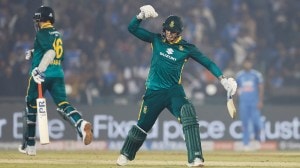Dalits in the New Millennium, edited by Sudha Pai, D Shyam Babu and Rahul Verma, explores the shifts in Dalit experience, set against the complexities of the current historical moment
The volume explores the challenges of developing an autonomous Dalit political platform that is premised on decisions based upon historical understandings of caste
 Dalits in the New Millennium, Edited by Sudha Pai, D. Shyam Babu and Rahul Verma, Cambridge University Press, 500 pages, Rs 1,195
Dalits in the New Millennium, Edited by Sudha Pai, D. Shyam Babu and Rahul Verma, Cambridge University Press, 500 pages, Rs 1,195 Dalit studies have flourished in recent years, stimulating a vibrant interdisciplinary conversation. Today, Dalit politics is a burgeoning field of academic study that celebrates institutional and extra-institutional aspects along with the ideological underpinnings of Dalit assertion and mobilisation. As part of this growing literature on the great churning in Indian democracy, Dalits in the New Millennium, edited by Sudha Pai, D Shyam Babu, and Rahul Verma, draws together 24 contributors who raise an exciting set of provocations concerning identity, discrimination, representation, and culture. Neither simplistic nor dense, there are potent arguments here that will draw attention to the linkages between Dalit mobilisations and their changing identities.
The authors ground their research in the historically unprecedented changes from the early 1990s when India saw the dramatic rise of Dalit leadership in grassroots organisations, political parties, and middle-class activism. They claim to draw the Dalit debate out of stereotypes engendered by the idealism of the earlier Ambedkarite and neo-Buddhist narratives. They also stand apart by not studying a single locale or region but by looking at ways young Dalits look beyond their communities, step into regional and social media, do online matchmaking, and augment their social capital. The volume documents the shift in Dalit experience, given their complexity and multiple uncertainties in the current historical moment and the shifting patterns of electoral politics. Thus, it provides a significant corrective to the standard representation of Dalit politics by showing them as critical agents in their own stories.
One of the volume’s central themes is how Dalit groups, mainly from the smaller and poorer sub-castes in the Hindi heartland, have shifted their allegiance dramatically towards the BJP, traditionally identified with opposition to the social justice agenda. If the deep majoritarian state and right-wing hegemony have been a success, was it a result of the pro-poor policies of the government, the able marketing of appropriate public schemes, or the alignment between the BJP’s ethno-political majoritarianism and the views of the BJP’s Dalit supporters? Finally, what is the effect and legacy of this shift or “drift”?
While the Bahujan Samaj Party’s steep decline and ideology are bemoaned, responses to its queries have been troubled by controversies and debates in recent years. Conceding that the right-wing agenda has been appealing enough to incorporate a large majority of the marginalised population, it is reasonable to conclude that most found something tangible to sway their allegiance. Here, the editors argue that globalisation and cultural shifts have inspired this heightened emphasis on being included within the saffron folds of a redefined subaltern Hindutva. The collapse of political ideologies created a historical moment rife with political possibility and presented Dalits with an occasion for creative negotiation of national identity and cultural belonging with a party espousing Hindutva.
However, despite the success of the BJP, Dalit politics has exhibited both preference and protest, as many chapters argue. Large-scale, violent protests took place after Rohith Vemula’s suicide, the flogging of Dalits, the desecration of Dalit symbols and icons, and the dilution of the Scheduled Castes and Scheduled Tribes (Prevention of Atrocities) Act, 1989 by the Supreme Court of India. However, prospects for the emergence of radical Dalit politics or a post-Ambedkar Dalit imagination (in newer outfits like the Bhim Army in Uttar Pradesh, Vanchit Bahujan Aghadi, Una Dalit Atyachar Samiti, etc.) committed to the critique of upper-caste dominance in a pan-Indian Dalit discourse is difficult to discern at the present conjuncture. Whether these new Dalit leaders can carry their mobilisation forward and create a strong movement or political parties remains to be seen.
A sizeable component of the chapters in the volume critically looks at the inclusionist perspective that dominated Dalit studies and practices on representation for a long time. The general premise was that the numerical strength of marginalised groups in state institutions could translate into the political arena as a radical formation. However, this rejection of the culture and aesthetics of the upper caste Hindu-dominated social elite did not lead to mounting an alternative cultural, intellectual, and political tradition. For the editors, there was a tendency to perceive caste categories as static and ahistorical rather than fluid and constantly being reconfigured. While there was a struggle to uproot caste, they were imprisoned by the language and logic of inverted caste.
Although scholars of Dalit politics have addressed many genres, very few spotlighted the operations of caste in popular culture as this volume does. Music, poetry, fiction, short stories, plays, and films illustrate societal issues, including caste and state-sanctioned violence; this window into Dalit literature returns the caste experience to a larger and enlarging cultural conversation.
Finally, the volume urges us to see the challenges for developing an autonomous Dalit political platform that is premised and dependent on decisions based upon historical understandings of caste. However, it is essential to note that self-imagining and self-perception exist within more significant historical understandings and legacies of caste. In a way, it resonates with post-caste critical writings that emphasize variable, multiple caste identities that willfully re-engage with the history and logic of caste. Although embodying critical trends, this work would have benefited greatly from the distinctive agendas of Dalit feminism and the alternative Dalit groups’ religious and cultural formations.
The eloquent introduction by the editors provides orientation through a complex and fractured history of Indian politics. We can only guess at this point how the complicated politics of caste competition and majoritarian politics in coalition building will connect with the equally complicated politics of middle-class Dalit alienation and poor Dalit marginality. Yet, the strength of the volume is that the contributors generally follow their logic, as clearly, any attempt to get the story straight would be an act of epistemic violence. Thus, in telling how Dalit identities have changed, it is essential to note there is no clear trajectory; there are competing theories within and links across, and contradictory possibilities and imaginings of identity.
Although not the first work of Dalit politics in the new millennium, the volume carries greater heft, in part because its publication comes at a critical moment of splintering of political issues and hence, of organisations into arenas that have become disconnected, depoliticised, and narrowly circumscribed.
Vidhu Verma is professor, Centre for Political Studies, JNU
- 01
- 02
- 03
- 04
- 05































